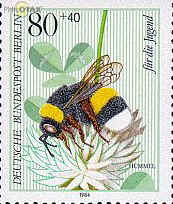We have been pondering on the significance of the laboratory evidence from Bee Researchers in France and the US that the administration of tiny amounts of a systemic neonicotinoid, imidacloprid, to bees was associated with a weakening of bee immunity, such that they became more susceptible to bee diseases. and decided to look more closely at the patterns of recent deaths/epidemics in the UK, Europe and the US, involving a variety of other wildlife. Massive declines in wild bumble bees in the US and Canada were reported in the late 1990s.
Colla (2008) in Ontario, previously a „hot spot‟ for bumble bees, sampled sites for three summers, 2004-6, in eastern North America [1]. Out of the 14 species that had been present in the same areas in 1971-73, three had disappeared completely and five of the remaining 11 were in steep decline. Of the species that had been fourth most common in the 1970s (14%), she found only one male. In 2008, the Xerces Society for Invertebrate Conservation reported that “bumble bee researchers across the continent have established that at least four species of formerly common North American wild species have experienced catastrophic declines over the past decade - two of them may be on the brink of extinction” [2]. In a status review by the Xerces Society and Dr Robbin Thorp (UC Davis), three formerly common species of bumble bee “went from being widespread and commonly found to rare or absent within a relatively short period of time (about 7-10 years)”. They were found to be infected with a series of unusual pathogens that entomologists attributed to unregulated movement of commercial bumble bees from Europe to pollinate greenhouses.
Developments in bumble bee breeding techniques in the previous 10 years or so had become “an essential part of modern agriculture” and allowed pollination in commercial greenhouses to take place out of season. In 2008, Ottenstatter & Thompson (Toronto) devised mathematical models and laboratory work to estimate „spillover‟ of the pathogen Crithidia bombi from greenhouses where imported bumble bees were being used for pollination [3]. They monitored wild bumble bee populations in the vicinity and found that the prevalence of C. bombi in wild bumble bees near to greenhouses appeared to support their model. In fact many bumble bee scientists became convinced that infections in imported bumble bees were at the heart of the declines in the wild population. A petition was sent in Jan 2010 from the Xerces Society, the Natural Resources Defense Council, Defenders of Wildlife and Dr Robbin Thorp to the USDA‟s Animal and Plant Health Inspection Service (APHIS) asking them to regulate the movement and health of commercial bumble bees to safeguard wild, native bumble bee pollinators. By Feb 2010, the situation was so bad that a broad coalition of 67 scientists (many of them bumble bee experts), sent a letter to The Hon Tom Vilsack, Secretary USDA in Washington and the Administrator of APHIS. However, Cameron and her colleagues (2011) were unconvinced by this „spillover‟ theory [4]. In a 3-year interdisciplinary study, they looked at changes in distribution, population genetic structure and levels of pathogen infection in bumble bee populations across the US. Comparing results with museum records of bumble bees they showed that the relative abundances of four species had declined historically by up to 96%. Geographical ranges had contracted by 23-87%, some within the past two decades. Those species that had declined had significantly higher infection levels of the pathogen Nosema bombi and had low genetic diversity compared with those that had not. They concluded that “cause and effect remain uncertain” for these “alarming patterns of decline in North America”. However, in the discussion, the authors said: “These observations are reminiscent of reports of other introduced fungal pathogens that pose widespread threats to some taxa” including frogs and bats.
References:
[1] Colla, S.R., Packer, L. (2008) Evidence for decline in eastern North American bumblebees (Hymenoptera: Apidae), with special focus on Bombus affinis Cresson. Biodivers Conserv 17: 1379-1391.
[2] Evans, E., Thorp, R., Jepsen, S., Black, S.H. (2008) Status Review of Three Formerly Common Species of Bumble Bee in the Subgenus Bombus. Xerces Society Website.
[3] Ottenstatter, M. C., Thompson, J.D. (2008) Does Pathogen Spillover from Commercially Reared Bumble Bees Threaten Wild Pollinators? PLoS One e2771.
[4] Cameron, S.A., Lozier, J.D., Strange, J.P., Koch, J.B., Cordes, N., Solter, L.F., Griswold, T. L. (2011) Patterns of widespread declines in North American bumble bees. Proc Natl Acad Sci USA 108: 662-667.
Authors:
Dr Rosemary Mason, MB, ChB (Hons), D.Obst. RCOG, FRCA. She worked in the UK National Health Service for about 35 years in: General Hospital Medicine and Obstetrics 3 years; Training in Anaesthetics and Intensive Care 8 years; Consultant Anaesthetist (Anesthesiologist) 25 years. Author of Anaesthesia Databook; A perioperative and peripartum manual (600 pages) as a practical resource for trained anaesthetists. 1st edn. 1989, 2nd edn. 1994, 3rd edn. 2001; reprinted in 2009. Assistant Editor of Anaesthesia, Journal of the Association of Anaesthetists of Great Britain and Ireland, 1990 – 2000.
Palle Uhd Jepsen, former Senior Adviser in Wildlife Management and Nature Conservation for the Danish Forest and Nature Agency, Ministry of the Environment. Research on the feeding ecology of goldeneye. Before his retirement he was a member of the Danish Delegation on the Ramsar Convention on Wetlands, International Whaling Commission, Bonn Convention on Migratory Species, ASCOBANS (Agreement on Conservation of Small Cetaceans in the Baltic and North Sea) and Wetlands International. Adviser on Site Management for International Projects in Thailand, Malaysia, Belarus, Northern Ireland and Estonia. Author of several books on natural and cultural history in Denmark; also natural history in the Arctic.
27th May 2011

- Log in to post comments
